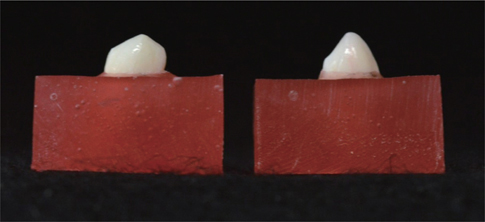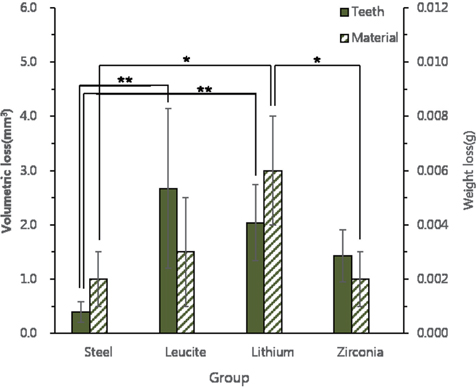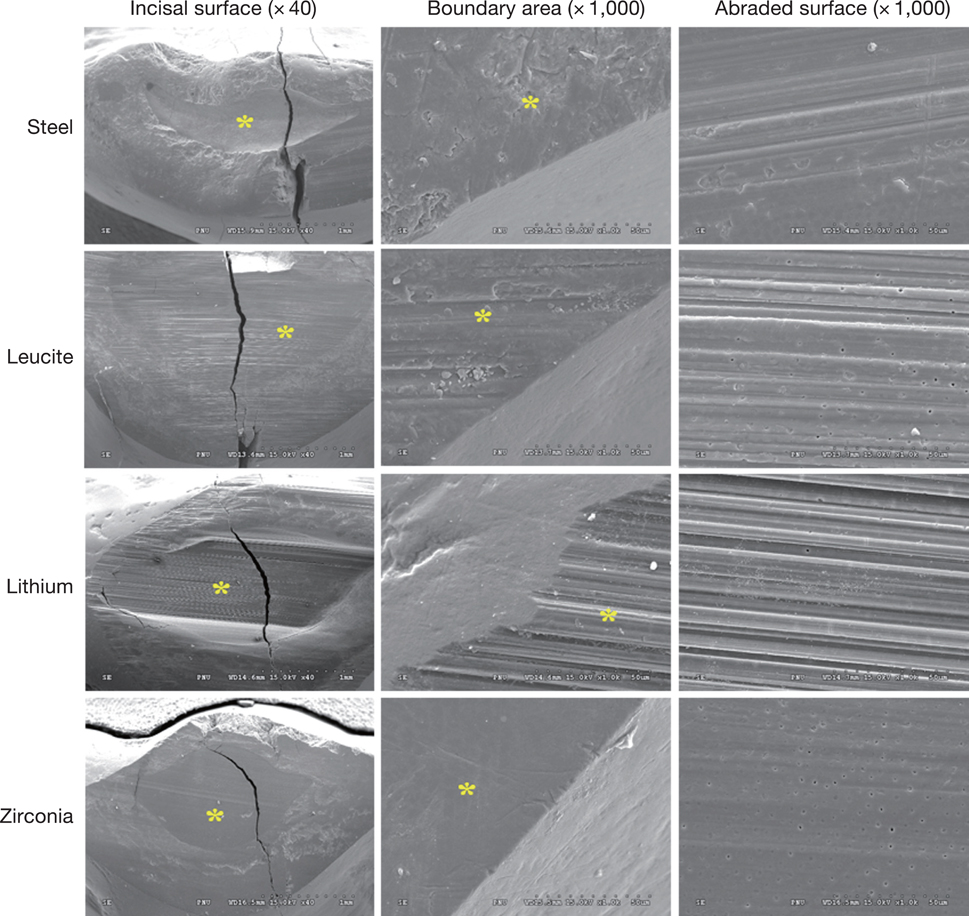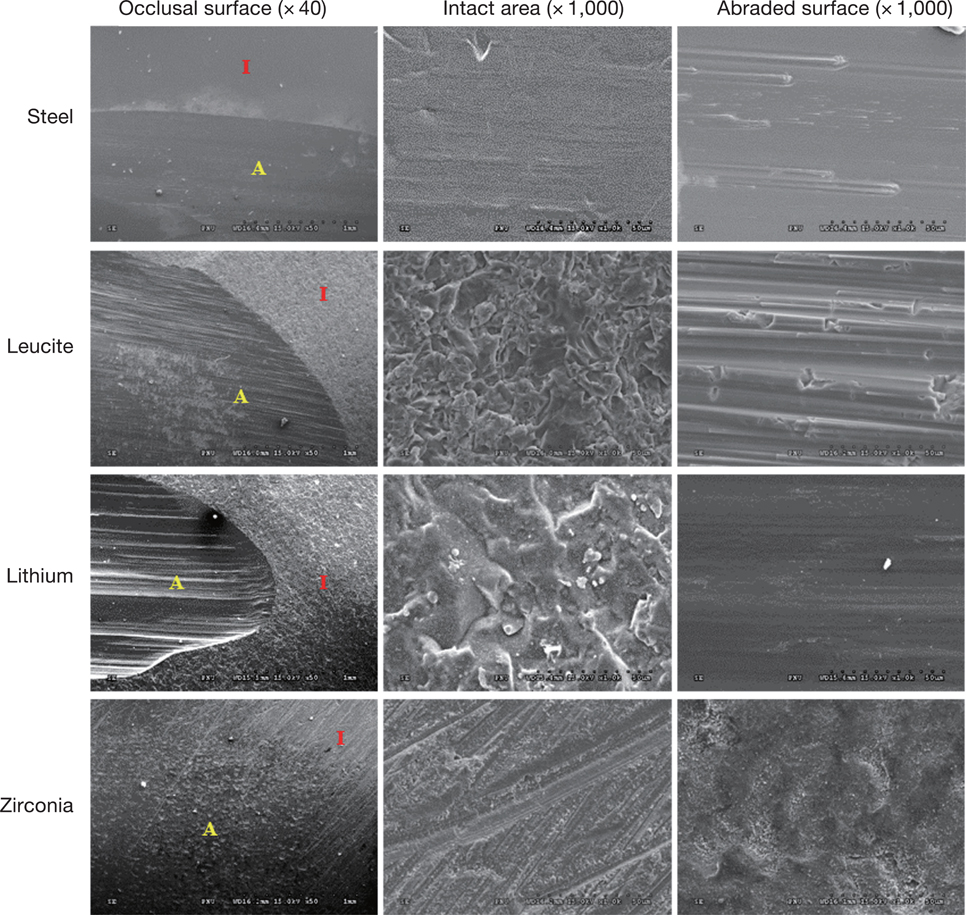J Adv Prosthodont.
2016 Feb;8(1):43-52. 10.4047/jap.2016.8.1.43.
Wear of primary teeth caused by opposed all-ceramic or stainless steel crowns
- Affiliations
-
- 1Department of Prosthodontics, Dental Research Institute, School of Dentistry, Pusan National University, Yangsan, Republic of Korea. huhjb@pusan.ac.kr
- 2Woorimi Dental Clinic, Busan, Republic of Korea.
- 3Department of Pediatric Dentistry, Dental Research Institute, School of Dentistry, Pusan National University, Yangsan, Republic of Korea.
- 4Dental Research Institute and Department of Biomaterials Science, School of Dentistry, Seoul National University, Seoul, Republic of Korea.
- 5EZ Plant, Seoul, Republic of Korea.
- KMID: 2393195
- DOI: http://doi.org/10.4047/jap.2016.8.1.43
Abstract
- PURPOSE
This study was conducted to evaluate the effects of full-coverage all-ceramic zirconia, lithium disilicate glass-ceramic, leucite glass-ceramic, or stainless steel crowns on antagonistic primary tooth wear.
MATERIALS AND METHODS
There were four study groups: the stainless steel (Steel) group, the leucite glass-ceramic (Leucite) group, the lithium disilicate glass-ceramic (Lithium) group, and the monolithic zirconia (Zirconia) group. Ten flat crown specimens were prepared per group; opposing teeth were prepared using primary canines. A wear test was conducted over 100,000 chewing cycles using a dual-axis chewing simulator and a 50 N masticating force, and wear losses of antagonistic teeth and restorative materials were calculated using a three-dimensional profiling system and an electronic scale, respectively. Statistical significance was determined using One-way ANOVA and Tukey's test (P<.05).
RESULTS
The Leucite group (2.670+/-1.471 mm3) showed the greatest amount of antagonist tooth wear, followed by in decreasing order by the Lithium (2.042+/-0.696 mm3), Zirconia (1.426+/-0.477 mm3), and Steel groups (0.397+/-0.192 mm3). Mean volume losses in the Leucite and Lithium groups were significantly greater than in the Steel group (P<.05). No significant difference was observed between mean volume losses in the Zirconia and Steel groups (P>.05).
CONCLUSION
Leucite glass-ceramic and lithium disilicate glass-ceramic cause more primary tooth wear than stainless steel or zirconia.
MeSH Terms
Figure
Reference
-
1. Humphery WP. Uses of chrome steel in children's dentistry. Dent Surv. 1950; 26:945–949.2. Randall RC. Preformed metal crowns for primary and permanent molar teeth: review of the literature. Pediatr Dent. 2002; 24:489–500.3. MacLean JK, Champagne CE, Waggoner WF, Ditmyer MM, Casamassimo P. Clinical outcomes for primary anterior teeth treated with preveneered stainless steel crowns. Pediatr Dent. 2007; 29:377–381.4. Shah PV, Lee JY, Wright JT. Clinical success and parental satisfaction with anterior preveneered primary stainless steel crowns. Pediatr Dent. 2004; 26:391–395.5. Zimmerman JA, Feigal RJ, Till MJ, Hodges JS. Parental attitudes on restorative materials as factors influencing current use in pediatric dentistry. Pediatr Dent. 2009; 31:63–70.6. Waggoner WF. Restoring primary anterior teeth. Pediatr Dent. 2002; 24:511–516.7. Waggoner WF, Cohen H. Failure strength of four veneered primary stainless steel crowns. Pediatr Dent. 1995; 17:36–40.8. Fuks AB, Ram D, Eidelman E. Clinical performance of esthetic posterior crowns in primary molars: a pilot study. Pediatr Dent. 1999; 21:445–448.9. Al-Amleh B, Lyons K, Swain M. Clinical trials in zirconia: a systematic review. J Oral Rehabil. 2010; 37:641–652.10. Townsend JA, Knoell P, Yu Q, Zhang JF, Wang Y, Zhu H, Beattie S, Xu X. In vitro fracture resistance of three commercially available zirconia crowns for primary molars. Pediatr Dent. 2014; 36:125–129.11. Seligman DA, Pullinger AG, Solberg WK. The prevalence of dental attrition and its association with factors of age, gender, occlusion, and TMJ symptomatology. J Dent Res. 1988; 67:1323–1333.12. Madléna M, Keszthelyi G, Alberth M, Nagy A. The attrition of deciduous teeth. Fogorv Sz. 1989; 82:273–276.13. Mahoney E, Holt A, Swain M, Kilpatrick N. The hardness and modulus of elasticity of primary molar teeth: an ultramicro-indentation study. J Dent. 2000; 28:589–594.14. Mair LH, Stolarski TA, Vowles RW, Lloyd CH. Wear: mechanisms, manifestations and measurement. Report of a workshop. J Dent. 1996; 24:141–148.15. Proffit WR, Fields HW. Occlusal forces in normal- and long-face children. J Dent Res. 1983; 62:571–574.16. Nose K. Study on the hardness of human and animal teeth. Jap J Exp Med. 1961; 69:1925–1945.17. Mortimer KV. The relationship of deciduous enamel structure to dental disease. Caries Res. 1970; 4:206–223.18. Nelson GV, Osborne JW, Gale EN, Norman RD, Phillips RW. A three-year clinical evaluation of composite resin and a high copper amalgam in posterior primary teeth. ASDC J Dent Child. 1980; 47:414–418.19. de Gee AJ, van Duinen RN, Werner A, Davidson CL. Early and long-term wear of conventional and resin-modified glass ionomers. J Dent Res. 1996; 75:1613–1619.20. Seghi RR, Rosenstiel SF, Bauer P. Abrasion of human enamel by different dental ceramics in vitro. J Dent Res. 1991; 70:221–225.21. Vann WF Jr, Barkmeier WW, Mahler DB. Assessing composite resin wear in primary molars: four-year findings. J Dent Res. 1988; 67:876–879.22. Villalta P, Rodrigues CR. In vitro occlusal wear of restorative materials on primary teeth. J Clin Pediatr Dent. 2005; 29:221–224.23. da Cunha MR, Puppin-Rontani RM, Ferracane JL, Correr-Sobrinho L. In vitro wear evaluation of dental materials in primary teeth. Am J Dent. 2006; 19:364–369.24. Jung YS, Lee JW, Choi YJ, Ahn JS, Shin SW, Huh JB. A study on the in-vitro wear of the natural tooth structure by opposing zirconia or dental porcelain. J Adv Prosthodont. 2010; 2:111–115.25. Sripetchdanond J, Leevailoj C. Wear of human enamel opposing monolithic zirconia, glass ceramic, and composite resin: an in vitro study. J Prosthet Dent. 2014; 112:1141–1150.26. Ashima G, Sarabjot KB, Gauba K, Mittal HC. Zirconia crowns for rehabilitation of decayed primary incisors: an esthetic alternative. J Clin Pediatr Dent. 2014; 39:18–22.27. Planells del Pozo P, Fuks AB. Zirconia crowns--an esthetic and resistant restorative alternative for ECC affected primary teeth. J Clin Pediatr Dent. 2014; 38:193–195.28. Al-Omiri MK, Harb R, Abu Hammad OA, Lamey PJ, Lynch E, Clifford TJ. Quantification of tooth wear: conventional vs new method using toolmakers microscope and a three-dimensional measuring technique. J Dent. 2010; 38:560–568.29. Albashaireh ZS, Ghazal M, Kern M. Two-body wear of different ceramic materials opposed to zirconia ceramic. J Prosthet Dent. 2010; 104:105–113.30. Kim MJ, Oh SH, Kim JH, Ju SW, Seo DG, Jun SH, Ahn JS, Ryu JJ. Wear evaluation of the human enamel opposing different Y-TZP dental ceramics and other porcelains. J Dent. 2012; 40:979–988.31. Amer R, Kürklü D, Kateeb E, Seghi RR. Three-body wear potential of dental yttrium-stabilized zirconia ceramic after grinding, polishing, and glazing treatments. J Prosthet Dent. 2014; 112:1151–1155.32. Lambrechts P, Braem M, Vuylsteke-Wauters M, Vanherle G. Quantitative in vivo wear of human enamel. J Dent Res. 1989; 68:1752–1754.33. Suzuki S. Simulated enamel wear during occlusal contact. Am J Dent. 2004; 17:373–377.34. Heintze SD, Zappini G, Rousson V. Wear of ten dental restorative materials in five wear simulators-results of a round robin test. Dent Mater. 2005; 21:304–317.35. Yap AU, Teoh SH, Hastings GW, Lu CS. Comparative wear ranking of dental restorative materials utilizing different wear simulation modes. J Oral Rehabil. 1997; 24:574–580.36. Heintze SD, Cavalleri A, Forjanic M, Zellweger G, Rousson V. Wear of ceramic and antagonist-a systematic evaluation of influencing factors in vitro. Dent Mater. 2008; 24:433–449.37. Ghazal M, Yang B, Ludwig K, Kern M. Two-body wear of resin and ceramic denture teeth in comparison to human enamel. Dent Mater. 2008; 24:502–507.38. Hahnel S, Behr M, Handel G, Rosentritt M. Two-body wear of artificial acrylic and composite resin teeth in relation to antagonist material. J Prosthet Dent. 2009; 101:269–278.39. Krejci I, Albert P, Lutz F. The influence of antagonist standardization on wear. J Dent Res. 1999; 78:713–719.40. Kunzelmann KH, Jelen B, Mehl A, Hickel R. Wear evaluation of MZ100 compared to ceramic CAD/CAM materials. Int J Comput Dent. 2001; 4:171–184.41. Magne P, Oh WS, Pintado MR, DeLong R. Wear of enamel and veneering ceramics after laboratory and chairside finishing procedures. J Prosthet Dent. 1999; 82:669–679.42. DeLong R, Douglas WH, Sakaguchi RL, Pintado MR. The wear of dental porcelain in an artificial mouth. Dent Mater. 1986; 2:214–219.43. Vrijhoef MM, Letzel H, Hendriks FH. A method to determine the loss of substance of dental restorations. J Oral Rehabil. 1985; 12:9–16.44. Oh WS, Delong R, Anusavice KJ. Factors affecting enamel and ceramic wear: a literature review. J Prosthet Dent. 2002; 87:451–459.45. White SN, Miklus VG, McLaren EA, Lang LA, Caputo AA. Flexural strength of a layered zirconia and porcelain dental all-ceramic system. J Prosthet Dent. 2005; 94:125–131.46. Ratledge DK, Smith BG, Wilson RF. The effect of restorative materials on the wear of human enamel. J Prosthet Dent. 1994; 72:194–203.47. Conrad HJ, Seong WJ, Pesun IJ. Current ceramic materials and systems with clinical recommendations: a systematic review. J Prosthet Dent. 2007; 98:389–404.48. Suzuki S, Leinfelder KF. Wear of enamel cusps opposed by posterior composite resin. Quintessence Int. 1993; 24:885–890.49. Fischer TE, Anderson MP, Jahanmir S. Influence of fracture toughness on the wear resistance of yttria-doped zirconium oxide. J Am Ceram Soc. 1989; 72:252–257.
- Full Text Links
- Actions
-
Cited
- CITED
-
- Close
- Share
- Similar articles
-
- Comparative Evaluation of the Survival Rates of Zirconia Crown and Stainless Steel Crown for Proximal Caries in Primary Molars: a Retrospective Study
- Comparison of Crown Shape and Amount of Tooth Reduction for Primary Anterior Prefabricated Crowns
- Frictional resistance of different ceramic brackets and their relationship to the second order angulation between bracket slot and wire
- A STUDY ON FRACTURE STRENGTH OF CONVENTIONAL AND COPY-MILLED IN-CERAM CROWNS
- Comparison of the frictional characteristics of aesthetic orthodontic brackets measured using a modified in vitro technique








